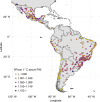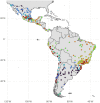City-level impact of extreme temperatures and mortality in Latin America
- PMID: 35760859
- PMCID: PMC9388372
- DOI: 10.1038/s41591-022-01872-6
City-level impact of extreme temperatures and mortality in Latin America
Abstract
Climate change and urbanization are rapidly increasing human exposure to extreme ambient temperatures, yet few studies have examined temperature and mortality in Latin America. We conducted a nonlinear, distributed-lag, longitudinal analysis of daily ambient temperatures and mortality among 326 Latin American cities between 2002 and 2015. We observed 15,431,532 deaths among ≈2.9 billion person-years of risk. The excess death fraction of total deaths was 0.67% (95% confidence interval (CI) 0.58-0.74%) for heat-related deaths and 5.09% (95% CI 4.64-5.47%) for cold-related deaths. The relative risk of death was 1.057 (95% CI 1.046-1.067%) per 1 °C higher temperature during extreme heat and 1.034 (95% CI 1.028-1.040%) per 1 °C lower temperature during extreme cold. In Latin American cities, a substantial proportion of deaths is attributable to nonoptimal ambient temperatures. Marginal increases in observed hot temperatures are associated with steep increases in mortality risk. These risks were strongest among older adults and for cardiovascular and respiratory deaths.
© 2022. The Author(s).
Conflict of interest statement
The authors declare no competing interests.
Figures





Comment in
-
Extreme temperatures and mortality in Latin America: Voices are needed from the Global South.Med. 2022 Oct 14;3(10):656-660. doi: 10.1016/j.medj.2022.09.004. Med. 2022. PMID: 36242999
References
-
- State of the Climate: Global Climate Report for Annual 2019 (NOAA National Centers for Environmental Information, 2020); https://www.ncdc.noaa.gov/sotc/global/201913
Publication types
MeSH terms
Grants and funding
LinkOut - more resources
Full Text Sources

